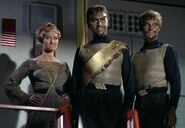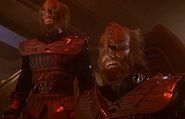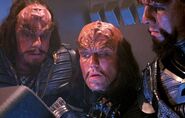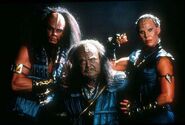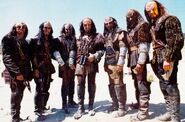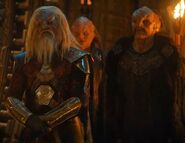- "A Klingon's honor means more to him than his life!"
- ―Kurn
Klingons are a spacefaring humanoid species from the planet Qo'noS (pronounced Kronos), and masters of the Klingon Empire, which controls a vast territory of space, bordering the United Federation of Planets and the Romulan Star Empire.
Known for their proud warlike mentality and adherence to a code of honor, Klingons have been one of the most influential species in the history of the Alpha and Beta Quadrants since at least the 22nd century, and have acted both as enemies and allies of the Federation.
Biology[]
Klingons are a humanoid species of plantigrade bipeds with an erect body posture and no tail. Their hands have five fingers, including an opposable thumb.
Their physical strength is at least on par with Vulcans, which are three times stronger than Humans. However, Klingons are not as strong as Human augments such as Khan Noonien Singh, which are five times stronger than regular Humans.
The Klingon lifespan is well over a hundred Earth years, as demonstrated by individuals such as Kang, Kor, Koloth and Arne Darvin, all of whom met Captain Kirk in the 2260s and were still alive and in good physical health by 2370. It appears that Klingon children develop much faster than Human children of comparative age, based on the accelerated growth rate observed in the hybrid Alexander Rozhenko (who is ¾ Klingon, ¼ Human).
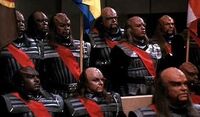
Like Humans, Klingons have a variety of skin colors.
Like Humans, Klingons have mostly hairless skin, with thick hair on their scalps, and males may grow facial hair in the form of mustaches and beards. According to Bolian barber Mot, Klingon hair is thick and luxuriant, which he described as "a pleasure to cut". Additionally, Klingons experience accelerated hair growth during jak'tahla, which is equivalent to Human puberty, along with other physiological changes such as gorchs, which look like large pimples. Like many other humanoids, Klingon hair turns grey in old age.
Klingons are more vulnerable to cold weather compared to other humanoids, such as Trills. Judging from the environment aboard Klingon ships, it appears that they prefer a darker environment as well. Alcohol has the same effect on them as it does on Humans. Unlike Humans, Klingons have a ribosome structure similar enough to Romulans to allow transfusions between the two species.
One peculiarity of Klingon biology is that they're entirely unaffected by the tranquilizing effect of Tribbles. In fact, Tribbles become furiously agitated in the presence of a Klingon.
According to Spock, Klingons don't have tear-ducts. However, it is known for a fact that they can still produce tears, at least under certain circumstances. History also tells that after the Klingon Kahless unified his people and taught them the principles of honor, he departed from the city and the people wept because they didn't want him to go. Similarly, another legend claims that Kahless wept for his deceased father, and the ocean was filled with his tears.
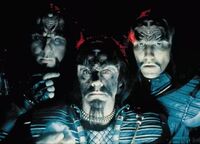
Klingons.
Most Klingons possess cranial ridges adorning their foreheads, which vary in shape from individual to individual, some being more elaborated, others less so. However, Klingons encountered in the 2260s lacked cranial ridges entirely and had a far more humanoid appearance as a result, to the point that some could easily pass off as Humans during that age. The reason for this is that the Klingon species was affected by a mutation due to a widespread infection by the Klingon augment virus, created as a failed attempt to enhance their species using genetic material from Human augments in the mid-22nd century. The mutagenic virus proved both infectious and lethal, and threatened to exterminate the Klingon population, until a Denobulan doctor named Phlox, working with Klingon physician Antaak, found a way to stabilize the condition by neutralizing the latter stages of the disease. While this solution saved the Klingon species and prevented harmful symptoms from the infection, the virus still altered the subjects' DNA, and the influence of Human genetics resulted in entire generations of Klingons being born without cranial ridges.
Evolution[]
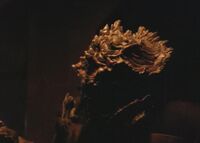
An unnamed evolutionary ancestor of the Klingon species.
Klingons evolved from large predators. The prehistoric ancestors of the Klingon species were formidable creatures with thorny exoskeletons, large mandibles and venom glands specialized for spitting a corrosive toxin at their prey: features that are no longer present in modern Klingons.
Internal anatomy[]
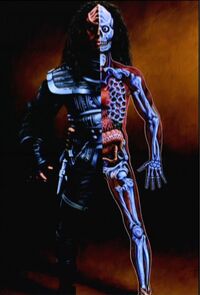
Klingon anatomy without the Augment virus.
The Klingon internal anatomy is characterized by a phenomenon known as brak'lul, described by Human scientist Toby Russell as "unnecessary redundancies". Compared to other humanoids, they have built-in backup systems in the form of additional or "overdesigned" organs, including 23 ribs, two livers, an eight-chambered heart and double-lined neural pia mater. According to Dr. Beverly Crusher, "almost every vital function in their bodies has a built-in redundancy in case any primary organ or system fails". This has the beneficial effect to allow Klingons to survive and recover from grave injuries better than most other humanoids. The downside, as expressed by Dr. Russell, is that "all the extra organs means just that much more can go wrong".
Due to the particularities of their culture, Klingon medicine hasn't developed as much as that of other spacefaring races, and there are aspects of their internal workings that remain unknown, even to Klingon authorities. For example, since a Klingon who suffers a paralyzing injury is usually left to die, research on neurological trauma was almost nonexistent as of 2368.
Blood[]
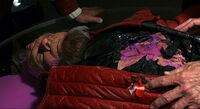
Purplish-pink blood.
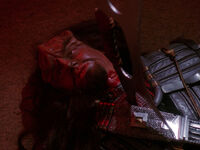
Red blood.
Klingon blood is often red, hardly distinguishable from Human blood, but can also be purplish-pink. It's not known whether the difference in blood color is due to phenotypic diversity, a difference between arterial and venous blood, or other reasons. It is even possible that Klingons might have two circulatory systems and two types of blood in their bodies, which might represent another aspect of their remarkable brak'lul (anatomical redundancy).
In 2293, a Human agent disguised as a Klingon had his identity exposed after being shot when Colonel Worf noticed that his blood wasn't Klingon blood. Since Klingon blood is often red, the fact that Worf was able to identify West as an impostor might have to do with other aspects of his blood, such as consistency or smell, rather than coloration. Alternatively, it's possible that Klingon eyesight can distinguish between Human blood and Klingon blood even if both might look red to Human eyes.
In 2381, a Klingon named Ma'ah claimed that "Klingon blood runs as reddish-pink as ever".
Cranial ridges[]
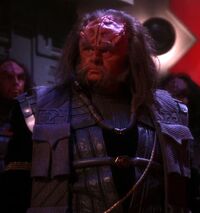
K'tal, a Klingon with pronounced ridges.
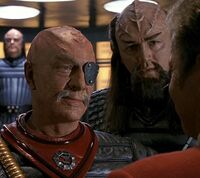
Klingons with less pronounced ridges.
Klingon cranial ridges vary in size and shape on an individual basis, and seem to be extraordinarily variable.
After the mutagenic virus spread through their species in 2154, Klingons acquired genetic traits from Human augments and lost their cranial ridges. The descendants of those afflicted with this condition were likewise born without ridges, and as a result look superficially Human-like, to the point that some can easily pass off as Human.
Eventually, at some point after 2269, the Klingons found a way to restore their original phenotype. Previously smooth-headed Klingons such as Kor, Kang and Koloth regained their ridges in old age, although whether as a result of genetic treatment or cosmetic surgery is not known. 24th century Klingons are born with cranial ridges, and look exactly as they did prior to 2154.
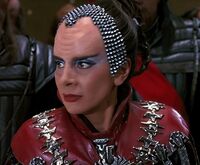
Azetbur.
There appears to have been a transitional period in the latter half of the 23rd century in which some Klingons displayed very smooth cranial ridges, quite unlike those of their 22nd and 24th century counterparts. Particularly, Klingon females from the late 23rd century such as Valkris, Vixis and Azetbur all have far less pronounced ridges than most contemporary males; although there are some males from this same period with very unpronounced ridges as well, as notably demonstrated by General Chang and others.
According to a Borg drone, shattering a Klingon's "cranial exoskeleton" at the tricipital lobe results in immediate death.
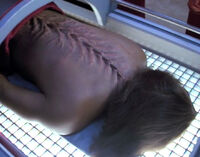
Klingon back ridges.
In addition to cranial ridges, Klingons also have ridges on their backs, running along the spine. It's currently not known whether the smooth-headed 23rd century Klingons share this particular trait.
Hybrids[]
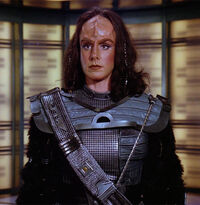
K'Ehleyr, a Klingon-Human hybrid.
Being descended from DNA molecules planted by the Ancient Humanoids, Klingons are distantly related to the other humanoid species of the galaxy such as Humans, Romulans and Cardassians, even though each evolved independently on their respective homeworlds. As a result, Klingons are genetically-compatible and can produce hybrid offspring with Humans and Romulans.
The Klingon phenotype tends to be prevalent in hybrids. Klingon-Romulan hybrids such as Ba'el can pass off as full-blood Klingons just by hiding their Romulan pointed ears.
Other variants[]
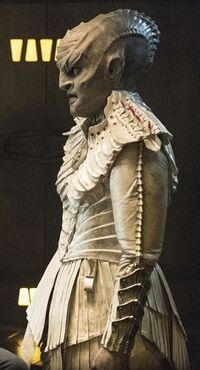
A Klingon with elongated skull.
A radically different type of Klingons appear to have been the dominant phenotype in the 2250s, making up both the Klingon High Council and the population of Qo'noS. Strangely, this type of Klingon has only been observed during that period.
These aberrant Klingons have a inhuman appearance, exemplified by such influential figures of the era as T'Kuvma and Chancellor L'Rell, look radically different from any other variant ever observed before or since. They have elongated skulls, broad noses with four nostrils, ears partially fused to the sides of their heads, sharp teeth which appear fused together, and talons on their fingers. They also seem to have more varied skin tones than normal Klingons, ranging from ebony to purplish-grey or copper.
Overall, these Klingons seem to be entirely unrelated to the smooth-headed Human-like Klingons who crewed the ships alongside the Federation frontier in the 2260s. While it is possible that some kind of segregation happened to prevent the augment virus from reaching the capital of the Empire, the origin of the T'Kuvma-style Klingons is not known. Assuming they're also mutated (albeit in a different way), that might be a contributing factor in their fervent hatred of the Federation.
Culture and society[]
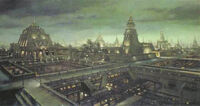
Qo'noS, homeworld of the Klingon species and Capitol of the Klingon Empire, is an M-class planet located in the Beta Quadrant of the Milky Way Galaxy.
Klingons are a warrior race which take pride in conquest and victory, seeking prestige and validation for both themselves and their bloodlines by deeds of honor and courage.
They're native to the M-class planet Qo'noS, which serves as capital of the Klingon Empire. Klingon families make up the Great Houses, which are represented in the Klingon High Council. A Chancellor serves as leader to the entire species.
Outside of battle, Klingons are a boisterous people who engage in festivities and enjoy eating, drinking, singing and trading playful insults. Their culture is rich in music, from songs that immortalize battles to the celebrated Klingon operas. Despite their historical enmity with Humans, they also have an appreciation for some aspects of Human culture, notably the plays of William Shakespeare: a sentiment expressed by Chancellor Gorkon, who joked that "you have not experienced Shakespeare until you have read him in the original Klingon".
Klingons are a monogamous and patriarchal race, and place great importance in familial ties. Rather than using surnames, a Klingon will introduce himself by stating his name and the name of his father (e.g. "I am Worf, son of Mogh"). They share the honors and the dishonors of their immediate relatives: a disgraced father equals a disgraced son. Klingon tradition holds that the son of a Klingon is a man the day he can first hold a blade.
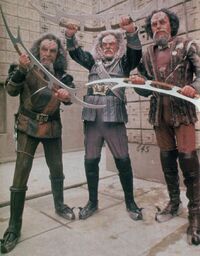
Even in old age, Klingons remain warriors.
Klingon culture is centered around the concept of honor, as taught by the founder of modern Klingon civilization, the warrior-emperor Kahless, who originally unified his people and created a code of conduct to be followed for centuries after his death. Honor and dishonor are more important than life and death for a Klingon. They prefer to die honorably in combat than to face the dishonor of being captured alive. Emphasis is also placed on courage, loyalty and battle skills.
However, Klingon honor differs somewhat from what most Humans would regard as honor. While they're usually upfront and hardly ever resort to the sneaky tactics employed by their Romulan and Cardassian enemies, they're not averse to deception, and will always ponder their options based on which strategy has the best chance of resulting in victory. To a Klingon, nothing's more honorable than victory.
Suicide is considered dishonorable among Klingons. However, a form of ritual assisted suicide exists, known as Hegh'bat, to allow those who can no longer fight and have become a burden to their families to die honorably, with the assistance of a friend or family member, preferably the warrior's own son. Similarly the controversial rite of Mauk-to'Vor allows a Klingon to kill a wrongfully disgraced brother and restore his honor upon death.
One (in)famous aspect of Klingon culture that has been often misunderstood by Humans is the custom that allows a Klingon officer to climb in rank by murdering his superiors. While this is technically true, there are strict restrictions: a superior officer can only be challenged by his immediate subordinate if the latter is convinced that the former is no longer fit to perform his duties. This practice serves to ensure that Klingons face pressure to perform their duties correctly, both from their superiors and from their subordinates.
Due to the strong emphasis on warrior mentality, Klingons who seek other professions may not be very well-regarded by their kin. Antaak was disowned by his father for becoming a physician, and Klingon scientists such as Kurak resent the lack of appreciation for their work. However, some Klingons have become respected in other fields, such as advocates who view the courtroom as a battlefield in which uncovering the truth represents victory.
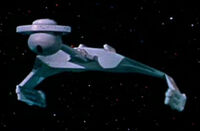
A Klingon D7-class battleship, used by the Klingon Empire during the 23rd century.
Like the Romulans, Klingons have been known to employ cloaking technology on their ships. This, along with the Romulans using Klingon designs on their ships in 2268, suggests that the two species have acquired technology from each other, possibly via a short-lived alliance before becoming blood enemies. The Klingons have also acquired holographic technology from the Xyrillians in 2151, long before holodecks became commonplace among other species.
Despite having access to advanced technology, a Klingon's favorite combat weapon is the bat'leth: a bladed weapon that can be held with one hand or both.
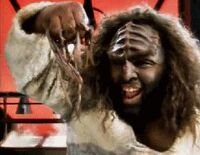
Klingon cuisine includes live racht.
Klingon cuisine, much like Ferengi cuisine, includes live invertebrates. The many varieties of gagh and racht are to be consumed alive. Half-dead racht is considered poor quality.
Klingons, for the most part, speak a single language across the Empire known as Klingonese, or simply Klingon, although dialects are known to exist. The Klingon language makes heavy use of guttural sounds and has phonetic features that are highly unusual compared to most Human languages, but can still be learned and spoken by other species, including Humans, Trills and Elaysians.
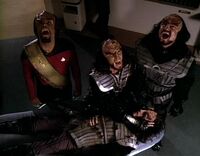
Klingon death ritual.
According to Kang, Klingons have no belief in the devil. However, they do believe in two types of afterlife: Sto-Vo-Kor is the destiny of those who die with honor, and its halls are guarded by Kahless himself. In contrast, those who die without honor end up in the hellish realm of Gre'thor, guarded at the gates by a monster known as Fek'Ihr. When a Klingon dies, it is customary for his peers to howl at the sky as a warning that a Klingon warrior is about to arrive in the afterlife.
Klingon courtship and mating rituals are violent by Human standards. It is traditional for Klingon females to roar, hurl heavy objects at their mates and claw at them, while the males read love poetry and duck a lot.
Klingons have domesticated species such as the Targ, the Klingon Monster Dog and the Jackal Mastiff.
The Klingon unit of currency is called the darsek.
Striking someone with the back of one's hand is considered a challenge to a battle to the death among Klingons. Keeping distance and speaking softly or whispering is considered extremely insulting.
Notable members[]
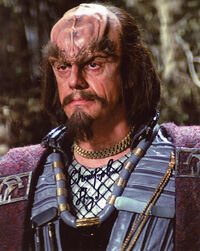
Commander Kruge.
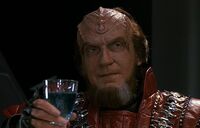
Chancellor Gorkon.
- Kahless: Emperor of the Klingon Empire, Kahless was also referred to as "Kahless the Unforgettable". He is also known to have forged his very sword, the first Bat'Leth, out of a lock of his own hair, thrust into the magma of the volcano at Kri'stak. During the 24th century, Kahless was cloned and this version of him came to rule the Klingon Empire once more, albeit as a religious figurehead rather than political.
- Worf: Son of Mogh and former lieutenant and current lieutenant commander of the USS Enterprise. Worf is also a friend of many aboard the Enterprise, including Jean-Luc Picard, Data, Tasha Yar, etc. He was initially a dishonored Klingon, until Gowron became chancellor, allowing Worf to regain his honor, after evidence of his family's innocence in the Khitomer Massacre was made known.
- Koloth: Former captain of the I.K.S Gr'oth and a legendary warrior among many Klingons. He was known to have had several run-ins with Capt. James T. Kirk during the 23rd century, most of which involving Tribbles.
- Kurn: The youngest son of Mogh and brother of Worf, Kurn was known to be a supporter of Gowron during the Klingon Civil War. This earned him a seat on the high council, but would be taken away when Worf refused to aid the Klingons in their attempted invasion of Cardassia.
- Gowron: Former Chancellor of the Klingon High Council, Gowron was a major player during the Klingon Civil War and was supported by Worf's brother Kurn. He allowed Worf to regain his honor, following new evidence of the Khitomer Massacre coming to light, proclaiming his father's innocence. Gowron however died on Deep Space 9 during a duel with Worf.
- Martok: Nicknamed the "Butcher" by the Tzenkethi, Martok is a well respected high ranking general of the Klingon Empire during the 24th and 25th centuries. Martok was a key player in the Dominion War, allied with the Federation against their common enemy and eventually, following Gowron's death, he rose to the rank of Chancellor of the Klingon High Council.
- Kruge: A commander in the Klingon Imperial Fleet of the 23rd century, Kruge was obsessed with gaining the Genesis Project for the Empire in hopes of using it as a weapon. He is indirectly responsible for the death of David Marcus, James T. Kirk's son. He engaged in combat with the Admiral, however died after falling into a lava stream beneath him.
- Korax: Captain Koloth's former executive officer aboard the I.K.S. Gr'oth, Korax, like his superior officer, was known to have descended from Klingons afflicted with the Augment Virus. He is also known to have started a bar fight with Chief Engineer of the USS Enterprise, Montgomery Scott on Space Station K7. This fight resulted in shore leave to be cancelled for both ships at the command of Captain James T. Kirk.
History[]
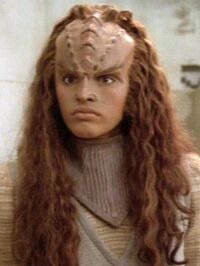
Ba'el, a Klingon-Romulan hybrid.
According to the Klingon belief system, the ancient Klingons killed the gods who created them because "they were more trouble than they were worth".
The father of modern Klingon civilization is Kahless the Unforgettable, who unified his people at some point in the 9th century and became the first Emperor of Qo'noS. Many centuries after his death, he remains the most influential figure in Klingon history and a name to be honored and respected by all Klingons. In 2269, an Excalbian described Kahless as "the Klingon who set the pattern for his planet's tyrannies".
After his job of unifying and teaching his people was done, Kahless departed to Sto-Vo-Kor, but promised his followers that he would return someday and pointed at a star in the night sky, telling the others to look for him there. The star system in question was later colonized by the Klingons, who found an M-class planet named Boreth, and built the Boreth Monastery to wait for the eventual return of Kahless.
In the 14th century, the Klingon homeworld of Qo'noS was invaded by a Gamma Quadrant species known as the Hur'q (a Klingon word that means "outsider"), which raided the planet and stole priceless treasures, including the Sword of Kahless.
It's not known precisely at which point Klingons developed space flight and warp drive. A Ferengi named Quark, having traveled back in time to 1947, claimed that if he could scavenge the warp drive of his ship and bring it to his home planet, the Ferengi would have access to warp drive "centuries before Humans or Klingons or even the Vulcans". The veracity of this statement is debatable, as it's known that the Vulcans were already a spacefaring civilization during that time, although it's possible that they might have used different forms of propulsion other than warp drive, the same being potentially true of the Klingons.
First contact between Klingons and Vulcans happened in 2016, and ended with the Vulcan ship being unceremoniously destroyed. After this failed attempt at diplomacy, the Vulcans adopted a new policy for every time they crossed paths with Klingons: opening fire first. This actually earned them the Klingons' respect. In 2367, when explaining the Federation's first contact procedures to the Malcorians, Captain Jean-Luc Picard claimed that "centuries ago, a disastrous contact with the Klingon Empire led to decades of war".
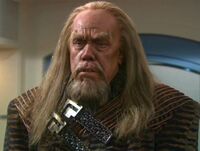
Dr. Antaak after losing his ridges from the modified Levodian flu.
In 2154, an attempt by the Klingon government to use genetic material from Human augments to enhance their species backfired gravely when it was found that one of the subjects was infected by the Levodian flu. The augment DNA modified the (normally harmless) Levodian flu virus, giving rise to the deadly Klingon augment virus, which quickly became epidemic. A treatment developed by Phlox and Antaak neutralized the lethal stages of the disease, but didn't prevent it from altering the subjects' DNA, resulting in the creation of smooth-headed Klingons, and entire generations of Klingons being born without cranial ridges.
For the next century following the outspread of the augment virus, the Klingons became far more isolated. While the smooth-headed phenotype made up the crew of Klingon vessels in the outskirts of the Empire, closer to the Federation border, it appears that not all Klingons were smooth-headed during that period. In 2256, the Klingon High Council and the planet Qo'noS itself were populated by a different type of Klingons with elongated skulls, taloned hands, different skin tones and more alien-like facial features. It is possible that the apparent segregation between these aberrant Klingons and the smooth-headed descendants of those afflicted by the augment virus came as an attempt to prevent the disease from reaching the capital of the Empire, although at this point this is mere conjecture. By the latter half of the 23rd century, the Klingon original phenotype was restored, and 24th century Klingons look the same as they did prior to 2154.
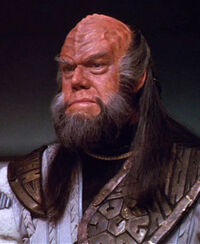
A Klingon ambassador.
Throughout the better part of the 23rd century, the Klingon Empire was inimical towards the United Federation of Planets: a situation that resulted in armed conflicts, such as the Battle of Donatu V in 2245, and culminated in a brief full-scale war in 2267, although the Organians intervened to put an end to it, forcing both sides to agree to the Organian Peace Treaty.
Despite the Organian treaty, relations between the Federation and the Klingons remained mostly sour: an uneasy peace punctuated by skirmishes and minor conflicts; until the signing of the Khitomer Accords of 2293, in which the two nations finally arranged for a true lasting peace on their own terms, thanks in large part to the efforts of the Klingon Chancellor Gorkon and the Human Starfleet officers James T. Kirk and Spock. After this, relations improved to the point that the Klingons were more often allies of the Federation.
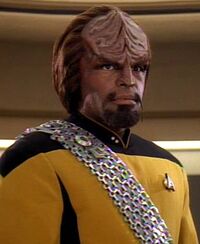
Worf, the first Klingon to join Starfleet.
Worf, a Klingon raised by Humans after his biological parents were killed in a Romulan attack on Khitomer, became the first Klingon to join Starfleet and served in the USS Enterprise-D under the command of Captain Jean-Luc Picard, and as strategic operations officer on space station Deep Space 9, under Captain Benjamin Sisko.
At some point after 2268, the Klingons were responsible for the systematic extermination of Tribbles, which they regarded as pests. Tribbles would be later brought back from extinction after the USS Defiant crew traveled back in time to 2268 and retrieved some living specimens.
In 2373, the Klingon Empire joined forces with both the Federation and the Romulan Star Empire in the Dominion War, fighting against Dominion, Breen and Cardassian forces to prevent a Dominion conquest of the Alpha Quadrant.
According to the temporal agent Daniels, by the 26th century, Klingons have joined the Federation.
Mirror universe[]
In the mirror universe, the Klingon-Cardassian Alliance rose to prominence in the 24th century, following the downfall of the Terran Empire, and enslaved Humans and Vulcans.
Gallery[]
Notes[]
- The Klingon language was originally created by actor James Doohan for Star Trek: The Motion Picture, and developed into a full-fledged language by linguist Marc Okrand. Nowadays, Klingon is one of the most popular constructed languages in the world, and the most popular constructed language created for an extraterrestrial species in fiction.
- A real Klingon opera named ʼuʼ premiered in The Hague, Netherlands, in 2010, and tells the story of Kahless. Before that, A Klingon Christmas Carol was the first play to be performed (almost) entirely in Klingon, premiering in 2007.
- In the original Star Trek series and the animated series, all Klingons are portrayed without cranial ridges, as the ridged design for the species wasn't created until the 1979 film Star Trek: The Motion Picture. From that point on, all Star Trek series and films would depict Klingons with cranial ridges.
- This discrepancy was acknowledged, but not resolved, in the Star Trek: Deep Space Nine episode "Trials and Tribble-ations": a celebration of the franchise's 30th anniversary in which the Deep Space Nine cast travels back in time to prevent the assassination of Captain Kirk. When asked about why the Klingons looked different back then, Worf responds that Klingons don't discuss that with outsiders. An explanation was eventually provided by the Star Trek: Enterprise two-part episode "Affliction" / "Divergence", introducing the mutagenic virus responsible for the change.
- The appearance of the historical emperor Kahless as a smooth-headed Klingon in the original series episode "The Savage Curtain" doesn't contradict canon because that Kahless was a simulation created by the Excalbians, who presumably recreated his appearance based on how Kirk and Spock would expect Kahless to look like, rather than how he actually looked like in life.
- Klingons have been portrayed with red blood in Star Trek: The Next Generation and Star Trek: Deep Space Nine, but with purplish-pink blood in Star Trek VI: The Undiscovered Country and Star Trek: Lower Decks.
- Despite taking place merely a few years before the original series, the Klingons featured in Star Trek: Discovery look radically different from both the smooth-headed Klingons routinely met by Kirk, and the default look of the species established in later productions. So far no explanation has been given for this discrepancy.
- In the first season of Star Trek: Discovery, the Klingons were also portrayed without hair, contradicting canonical acknowledgements that Klingons have hair, such as in the Star Trek: The Next Generation episodes "Schisms" and "Rightful Heir", and in Star Trek: Insurrection. This particular discrepancy was remedied in the second season, which shows the Klingons with hair and beards, and mentions that they had previously shaved for the war.
- Comparing L'Rell's appearance in the first and second seasons of Star Trek: Discovery reveals that, besides growing hair, the shape of her skull was altered radically, from elongated and alien in the first season, to a far more human-like shape in the second season. No explanation has been given for this, but since it's unlikely that Klingons can alter the shape of their skulls, it's probably best regarded as a simple make-up alteration, similar to how Worf's appearance changed throughout his appearances in TNG.
- The Klingon species was indirectly mentioned via the first Klingon emperor, Kahless, in Joan D. Vinge's 1977 short story "To Bell the Cat". The story mentions "Piper Alvarian Jary, who had served a man who made Attila the Hun, Hitler, and Kahless look like nice guys".
- A Klingon Embassy is featured in the Futurama episode "A Taste of Freedom". Humorously, the embassy is pink and looks the opposite of what would be expected from Klingon aesthetics.
- While not portrayed, the Klingons are also a species in Michael Herbig's Bullyparade universe, being mentioned in two sketches of the sketch series Unser Traumschiff.
- The Klunkins from Duck Dodgers are a parody / homage to the Klingons.
